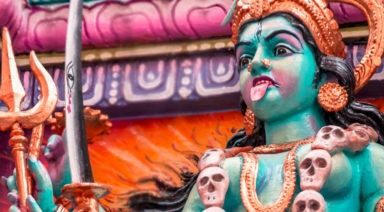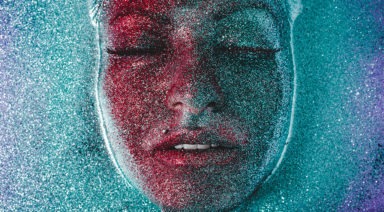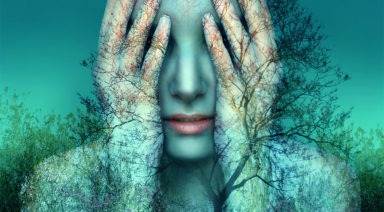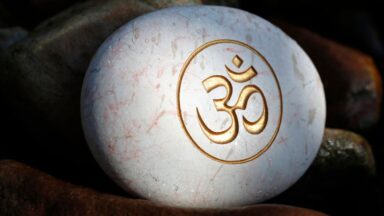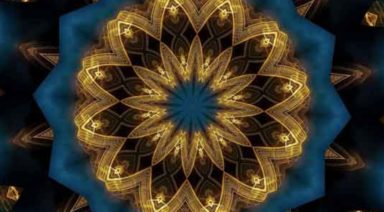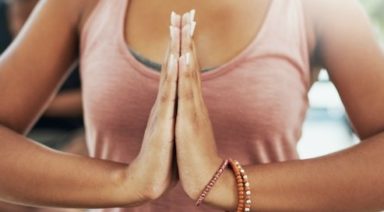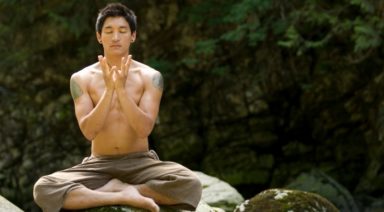Goddess Guide: Mantra and Mudra
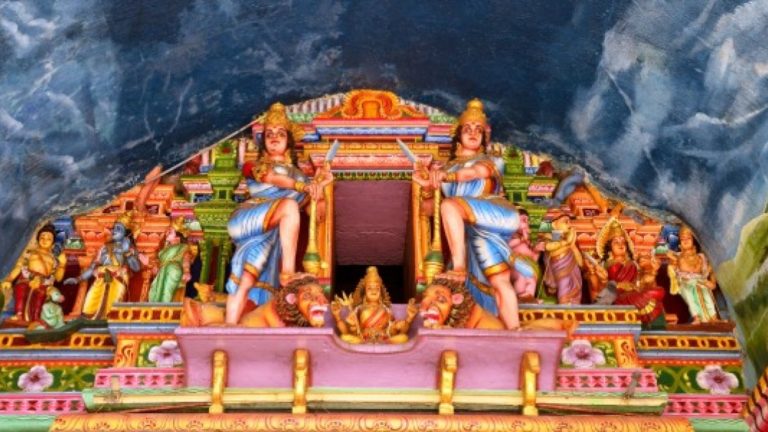
When I was 15, I met a goddess on the NYC subway. I had lied my way into scoring a weekend pass away from my all-girls boarding school in upstate New York. Three trains and a subway later, I was in the city and looking to get into trouble. Sitting on the downtown line a flash of red caught my eye. I turned and saw Wonder Woman. Riding the subway.
I felt the immediate collision between my adolescent agenda to misbehave and Wonder Woman’s destiny to fight injustice. As if ensnared by her Lasso of Truth, I decided to forgo my punkass plan, got off at the next stop and slowly retraced my way back to school. I knew that it wasn’t really Wonder Woman on that subway, it was just a tall woman in a crazy red and blue sequined outfit, but in that moment I was suddenly open to more than just my self-serving perspective. I believe that’s the great power of deities and what we love about them.
I’ve traveled a lot and worked all over the world, and have seen a lot of Goddesses. In Thailand, I saw temple paintings of the Goddess Manimekhala, said to be the goddess of lightning and the seas. When I was in India the first time, I visited many many temples including one of the most renowned temples of Goddess Durga, the Jwalamukhi Devi temple in Himachal Pradesh. Try going to India and not visiting a temple; they are everywhere! Like sets of Russian dolls, there are tiny temples increasing in size, all leading towards the actual temple you’re seeking. On my second visit to India, I attended a puja (ceremony) honoring the goddess Kali.
When we hear the word Goddess, we typically think of is everything from the Virgin Mary to Xena Warrior Princess. All of these connections are born out of the stories or myths that we’ve heard; and they exist in nearly every culture imaginable.
Myths are one of the ways we try to explain the things in the world that seem to defy our understanding. We have myths explaining why winter turns into spring. We have myths for why the sun travels across the sky each day.
The tradition of yoga is steeped in story.
Stories that cover everything from breathing patterns to the shapes we take with our bodies (asanas), and our hands (mudras), to the sounds (mantras) that connect us vibrationally to the physical world. The Sanskrit word mantra is comprised of two words:
- Manas, meaning mind, specifically the space of the mind in which the heart and mind align (a place void of mental chatter; an openhearted mental space)
- Tra, tools or instruments, specifically the emanation of the space of manas or vibrational/sonic expression of manas
The Goddess Guide
Here are some descriptions, mantras and mudras for four of the most popular goddesses in the yogic tradition: Lakshmi, Saraswati, Durga, and Kali. In fact I’ll toss in a few more: Sita, Usas, Yemaya for good measure.
Lakshmi
I saw a beautiful tattoo of Lakshmi once, it covered this guy’s entire back. She was depicted with four arms coming out of her body and hands holding symbols of wealth (symbolic of ethics, wealth, love, and liberation. These are the four good goals of humanity according to Hinduism). Lakshmi is the one you want for your personal wealth management consultant, because trust me, she’s got it all.
She’s got prosperity, beauty, grace and generosity. And she’s goal oriented; she knows and understands goals. That’s the essence of her name: that the goal of life is to be prosperous, in both worldly and spiritual ways. Lakshmi is also where we derive our English word ”luck”. You want Lakshmi on the payroll. She’s not afraid of giving and receiving abundance. She’s like Lady Gaga working at Charles Schwab. All the abundance you can handle.
Mudra
Lakshmi is represented by holding one or both hands in what called Kapitta Hasta. With the palm facing outward, curl the middle, ring, and pinky fingers into the center of the palm. Bend the index finger at the middle knuckle and press the thumb to the outer side of the index finger.
Mantra
Om Shri Maha Lakshmyai Namah salutations to great goddess Lakshmi, the goddess of fortune and wealth.
Saraswati
Saraswati is probably having lunch with David Bowie right now. She’s all about the music, the arts, communication and the sciences. You climb the mountain and want inspiration? Saraswati is probably sitting at the top. On a lotus. And her white clothes and fair complexion don’t show a spot of dirt. She too has multiple arms holding a Veena (string instrument) for all manifest sound/music, a rosary, symbolizing the power of meditation, and the vedas, ancient, sung verses containing the wisdom to maneuver through life’s difficulties.
Mudra
Bend the right elbow, with the right hand in front near the chest with thumb and middle finger touching, index finger extended. The left arm is raised with the left hand in Kapitta Hasta mudra.
Mantra
When we are wanting inspiration, or searching for the right words to say, chant to Saraswati. Aum Shri Saraswati Namaha. May I recognize the wisdom within me.
Durga
Durga should have been one of the X Men. Let me tell you why. She’s often depicted with 8-10 arms; each bearing a different weapon. And she rides lion. Durga is a protector who removes misery and eliminates suffering. Basically a badass mama whose got your back. The word “Durga”; in Sanskrit means a fort or place virtually impossible to overrun. She’s essentially indestructible.
Mudra
Make fists with both hands. Cross thumb under curled index finger on each hand. The Durga mudra simultaneously creates courage and calm.
Mantra
Om Dum Durgayei Namaha invokes the feminine energy which protects from all negative influences.
Kali
If the day your boyfriend left you was also the day you wrecked your car, and was the same day you found out your dog was sick, then congratulations, you’ve met Kali. And the thing about Kali is that she’s not one thing. She’s this elemental force of change; death is always transformation, change is always death. Kali’s job is to kill the other thing you did not choose; she operates in the realm of discernment. She’s most often represented wearing a necklace of heads, and a skirt make of human arms. Kali wields a knife dripping with blood. For real.
Mudra
Interlace all the fingers and the thumbs together in front of the chest. Extend the index fingers, with pads pressing against each other and point index fingers upward.
Mantra
Om Krim Kalikayai Namah I bow my head to the Goddess Kali.
Goddesses All Around
Lakshmi, Saraswati, Durga and Kali are by no means the only Goddesses out there. There’s Usas (Ushas) who’s the Goddess of the dawn, Sita, an avatar of Lakshmi; she’s the perfect wife to Ram, the revered June Cleaver of the Hindu world. And Yemaya, the Goddess of the ocean.
And if none of these goddesses turn you on, guess what, you’ve got a lot of other choices. There are powerful, feminized mythological figures out there for every human condition, for every human emotion for everything that happens throughout the world. Here’s the bottom line. These names are ancient and these characters are mythological.
But to believe in the sacred feminine, to believe in the role and the presence of all of these goddesses is to believe they are here today. They are not just stories from ancient history. They are part of how we live and interact with one another today. You have these goddesses within you. And they are all around you.
They are in line with you at Starbucks. They are in front of you on the escalator at the mall. Look for these goddesses everywhere. Don’t just look for them in history books or on the walls of temples. Go find them. Be them.
Creating the Container for Kali: How the Goddess Shows Up in Your Life
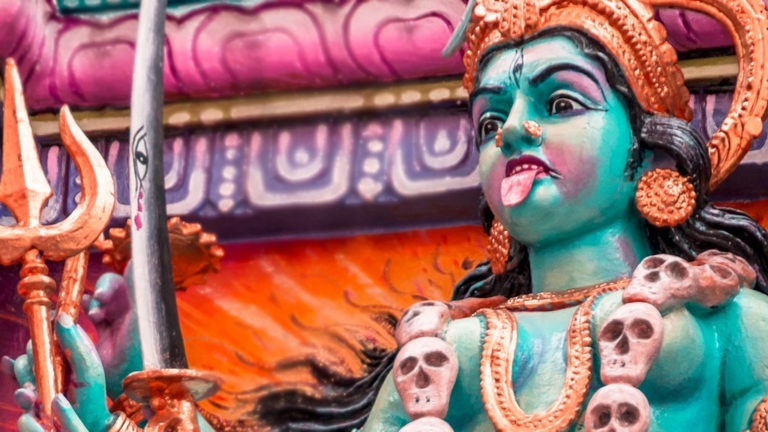
When I found her, Kali was waiting in the window of the Ma Shrine (a temple for female deities) at my new ashram home. I was mesmerized. She didn’t look anything like the other goddesses in the temple which was filled with examples of the feminine divine. All the other goddesses were wooden or metal, seated on a lotus or astride a peaceful looking mount. Even Durga carrying all her weapons and emanating powerful assurances sat calmly atop her tamed tiger.
In contrast, Kali was a smaller wooden statue painted in the brightest colors of the room. With jet black skin and the reddest tongue extended through her open mouth, reaching for me as if to swallow me whole, she wore a necklace of severed heads and a skirt of severed limbs.
She stood atop a resigned Shiva Lord of the Universe as a conqueror claims their prize. There was nothing peaceful about her! She was ferocious, and everything about her image should have been terrifying in my context of non-understanding. But I wasn’t afraid. I was drawn to her.
Kali was the first goddess I would ever have a relatable experience with from energetic understandings that lay beyond the perception of her form. I sat there and looked to her for what seemed like hours. Every day I would go to the Ma Shrine after our morning meditations and visit all the mother goddesses, offering Kali a flower and trying to feel what she was awakening in me: my power.
Years later, I became a mother myself. The day I became a mom, was the most beautiful experience of celebrating life and specifically that of my son, who is my everything. He is a constant source of inspiration for me still, just six and a half years along my journey into becoming a mother goddess. Love like this has no description you can place from pen to paper.



